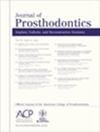Effects of complete-arch digital scanning techniques on the passive fit of CAD-CAM verification devices
Abstract
Purpose
To evaluate the impact of different complete-arch digital scanning techniques on the passive fit of computer-aided design and computer-aided manufacturing (CAD-CAM) verification devices.
Materials and Methods
A mandibular master cast with four multiunit abutment implant analogs was used as the basis for fabricating verification devices through three impression techniques. Group 1 employed a conventional open-tray impression technique using polyvinyl siloxane material, Group 2 utilized digital scans of splinted scanbodies reinforced with a light-polymerizing acrylic resin and metal mesh, and Group 3 applied digital scans of reverse scanbodies connected to a passively fitting interim prosthesis. A total of 60 CAD-CAM verification devices were fabricated, including 10 milled and 10 3D-printed devices across the three groups. The misfit of verification devices was assessed using visual inspection, tactile sensation, and a one-screw test, with any disagreements between the two primary examiners resolved by a third evaluator. Agreement between the clinicians was assessed using crosstabs, kappa statistics, and percent agreement separately for the visual and tactile evaluations. The percentage of misfits was calculated for each group and compared between groups using Fisher's exact tests (α = 0.05).
Results
Milled verification devices exhibited superior passive fit compared to 3D-printed devices across all groups. The Group 1 conventional open-tray technique with milled devices achieved a misfit percentage of 0%, significantly outperforming other groups. Group 3 reverse scanbodies with milled devices followed with a 20% misfit rate, while Group 2 splinted scanbodies with auxiliary features and milled devices showed the highest misfit rate at 60%. Among 3D-printed devices, Group 1 had the lowest misfit rate at 50%, followed by Group 3 at 60%, and Group 2 at 80%. The agreement between examiners was substantial, with a kappa statistic of 0.77 and 88% consistency. Statistical analysis revealed significant differences in misfit rates, highlighting the advantages of conventional methods and milled devices in achieving superior fit.
Conclusion
The conventional splinted open-tray impression technique, combined with milled verification devices, demonstrated superior fit and outperformed other impression and manufacturing techniques. The reverse scanbody protocol performed better than splinted scanbodies with auxiliary features, although it still showed variability. Conversely, 3D-printed verification devices demonstrated higher misfit rates, limiting their clinical applicability for verifying implant positions in complete-arch prostheses.


 求助内容:
求助内容: 应助结果提醒方式:
应助结果提醒方式:


